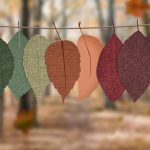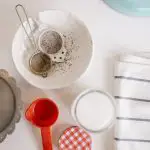When dealing with fabric bleeding, you can choose between home remedies or store-bought products. Home remedies like vinegar or baking soda are gentle and budget-friendly, but might need multiple applications for stubborn stains. On the other hand, store-bought solutions, like OxiClean, work quickly and effectively but may contain harsh chemicals. Ultimately, your choice depends on the severity of the bleeding and your preference for cost or convenience. There’s more to explore about maintaining vibrant colors in your fabrics!
Table of Contents
Key Takeaways
- Home remedies like vinegar and baking soda are budget-friendly options for mild stains, but may require multiple applications for effectiveness.
- Store-bought products, such as OxiClean and Rit Color Remover, often provide quicker results for tougher stains but may contain aggressive chemicals.
- Always test any solution on hidden fabric areas before applying it to prevent further damage.
- Preventative measures, like washing darks separately and using cold water, can significantly reduce the risk of fabric bleeding.
- Consider the severity of the stain and personal budget when choosing between home remedies and commercial products for optimal results.
Understanding Fabric Bleeding
When you wash new clothes for the first time, you might notice that the colors bleed, ruining other garments in the process. This bleeding occurs when dyes in the fabric release during washing, often due to heat, agitation, or water.
It can lead to unsightly stains on lighter fabrics and can be particularly frustrating when you’ve just invested in a new wardrobe. Understanding fabric bleeding is essential for protecting your clothes.
You’ll want to identify fabrics that are more prone to bleeding, such as bright or dark colors. By being aware of this issue, you can take preventative measures to minimize damage, ensuring your laundry routine remains effective and your clothes stay vibrant and intact.
Common Causes of Fabric Bleeding
Fabric bleeding often happens with vivid color fabrics, especially when they’re new.
The dye used in these garments can be unstable, causing colors to run during washing or exposure to moisture.
Understanding these common causes can help you take preventive measures before any damage occurs.
Vivid Color Fabrics
Vivid color fabrics often face the risk of bleeding, especially if they’re not treated properly. One common cause is the use of low-quality dyes, which can easily transfer to other fabrics during washing.
If you wash bright colors with lighter shades, you’re also inviting trouble; the pigments can mix and create unwanted stains. Additionally, high water temperatures can exacerbate bleeding, causing those vibrant hues to run.
To minimize this risk, always check care labels and opt for cold water washes. Pre-soaking your vivid fabrics in a vinegar solution can help set the colors.
Finally, avoid overloading your washing machine; giving your clothes space can reduce friction and the chance of bleeding, keeping your colors bright and intact.
New Garment Dye
New garment dye techniques have become popular for achieving vibrant colors, but they can also lead to significant fabric bleeding if not handled with care.
When you wash a newly dyed garment, the excess dye can release, especially in the first few washes. This is often due to inadequate fixation during the dyeing process or low-quality dyes. If you mix these pieces with lighter colors, you risk staining them.
To minimize bleeding, always wash new items separately in cold water using a gentle cycle. You might also want to use a color catcher sheet to absorb any loose dye.
Home Remedies for Fabric Bleeding
When dealing with fabric bleeding, you can turn to some effective home remedies.
A vinegar solution can help set colors, while baking soda works wonders for stains.
Just remember to use hydrogen peroxide with caution, as it can lighten fabrics if not applied carefully.
Vinegar Solution Benefits
Vinegar is a powerful ally in tackling fabric bleeding, and it’s often just a household staple away. When you encounter dye transfer on your clothes, using white vinegar can help lift those unwanted colors. Simply mix one part vinegar with two parts water and soak the affected area. This solution works to neutralize the dye, preventing further bleeding.
Additionally, vinegar acts as a natural fabric softener, leaving your clothes feeling fresh and soft after washing. It’s also non-toxic, making it a safe choice for your family and the environment.
Baking Soda Application
Baking soda is a versatile and effective remedy for combating fabric bleeding. To use it, mix a quarter cup of baking soda with water to create a paste.
Apply this paste directly to the stained area of the fabric, making sure it covers the entire spot. Let it sit for about 30 minutes, allowing the baking soda to absorb the excess dye.
Afterward, rinse the fabric thoroughly with cold water to remove the paste and any loosened dye. If the stain persists, you can repeat the process.
It’s a gentle solution that works well on most fabrics without causing damage. Just remember to always test it on a hidden area first to verify it won’t affect the color.
Hydrogen Peroxide Precautions
While baking soda is a gentle approach to treating fabric bleeding, hydrogen peroxide can be a more potent solution for tougher stains.
However, you should take some precautions when using it. First, always test a hidden area of the fabric to verify it won’t cause discoloration. Hydrogen peroxide can lighten colors, so be careful with vibrant hues.
Use it in a well-ventilated area, as the fumes can be strong. When applying, consider diluting it with water to reduce its strength, especially on delicate fabrics.
Also, wear gloves to protect your skin. Finally, don’t leave hydrogen peroxide on the fabric for too long; rinse it thoroughly to prevent any potential damage.
Store-Bought Products for Fabric Bleeding
When dealing with fabric bleeding, you might find that store-bought products can be your best allies. These specialized solutions are designed to tackle color transfer effectively and often yield quicker results than home remedies.
Look for stain removers specifically labeled for color bleeding; they usually contain ingredients that target dye transfer without damaging your fabric. Brands like OxiClean, Rit Color Remover, and Shout offer various formulations that can help restore your garments.
Just follow the instructions on the label, and you’ll likely see significant improvement. Keep in mind that some products work better on specific fabrics, so check compatibility before use.
With the right store-bought solution, you can reclaim your favorite clothes from unwanted color mishaps.
Precautions and Safety Measures
Using store-bought products for fabric bleeding can be effective, but it’s important to prioritize safety while tackling these issues. Always read the label before use to understand the ingredients and any potential hazards.
Wear gloves to protect your skin, and work in a well-ventilated area to avoid inhaling fumes. If you’re unsure about a product, test it on a hidden fabric area first.
Keep these products out of reach of children and pets to prevent accidental ingestion. Additionally, avoid mixing different cleaning agents, as this can create dangerous reactions.
Finally, always wash your hands thoroughly after handling these chemicals to guarantee no residue remains. By taking these precautions, you can safely address fabric bleeding issues.
Preventative Measures for Fabric Bleeding
To prevent fabric bleeding, it’s essential to select your clothing and textiles carefully, especially when mixing colors in the wash.
Always separate darks from lights to avoid any unwanted dye transfer. Additionally, consider pre-washing new garments separately to eliminate excess dye. When possible, opt for colorfast fabrics, which are less likely to bleed.
Separate darks from lights and pre-wash new garments to prevent unwanted dye transfer. Opt for colorfast fabrics whenever possible.
Using cold water can also help, as it tends to preserve colors better than hot water. If you’re concerned about a particular item, you might test it by dampening a hidden area and pressing it with a white cloth to check for color transfer.
Finally, avoid overcrowding the washing machine, as this can lead to agitation and increase the risk of bleeding.
Choosing the Right Solution
Even with careful preventative measures, fabric bleeding can still occur, leaving you searching for effective solutions. When choosing the right remedy, consider factors like fabric type, severity of the stain, and your personal preferences. You might find that some solutions work better for specific fabrics or stains.
Here’s a quick comparison to help you decide:
| Solution Type | Best For | Considerations |
|---|---|---|
| Home Remedies | Mild stains on delicate fabrics | Time-consuming, may vary in effectiveness |
| Store-Bought Products | Tough stains on various fabrics | Quick results, but may contain harsh chemicals |
| Natural Solutions | Sensitive skin or eco-friendly options | May require multiple applications |
Comparing Effectiveness: Home Remedies vs. Store-Bought
While you may prefer the convenience of store-bought products, home remedies can often be surprisingly effective for fabric bleeding. Many people find that simple ingredients from their kitchens can tackle color transfer just as well, if not better, than commercial solutions.
Here’s a quick comparison:
- Home Remedies: Common items like vinegar or baking soda can lift stains naturally, often without harsh chemicals.
- Store-Bought Solutions: These are specifically designed for fabric bleeding and may provide quick results, but they can sometimes contain aggressive ingredients.
- Cost: Home remedies are generally more budget-friendly, while store-bought solutions can add up over time.
Ultimately, the choice depends on your preferences and the severity of the bleeding.
Tips for Maintaining Color Integrity in Fabrics
Maintaining color integrity in your fabrics requires a proactive approach, so you can enjoy vibrant textiles for longer.
Always wash your colored fabrics in cold water to prevent fading. It’s also smart to separate darks from lights before laundry to avoid unwanted bleeding. Use a gentle detergent designed for colored fabrics, and skip bleach, as it can strip colors.
When drying, opt for air drying whenever possible, as sunlight can fade colors over time. If you must use a dryer, choose a low heat setting. Additionally, consider storing your fabrics away from direct sunlight to preserve their hues.
Finally, if your fabric needs a refresh, a fabric-safe color booster can help maintain its vibrancy without damaging the material.
Frequently Asked Questions
How Can I Remove Color Bleed From Upholstery Fabrics?
To remove color bleed from upholstery fabrics, you can gently blot the area with a damp cloth, apply a mixture of water and vinegar, or use a specialized upholstery cleaner. Always test on an inconspicuous area first.
Will Fabric Bleeding Affect the Longevity of My Clothes?
Fabric bleeding can indeed affect your clothes’ longevity. When colors mix, it weakens fibers, leading to faster wear and tear. To keep your garments looking fresh, address any bleeding issues promptly and carefully.
Can I Mix Home Remedies With Store-Bought Products?
Imagine blending colors on a canvas; you can mix home remedies with store-bought products, but be cautious. Some combinations may cancel each other out or cause unwanted reactions. Test small areas first before diving in.
How Often Should I Use Color Catchers in Laundry?
You should use color catchers in every load of laundry, especially when washing mixed colors. They help absorb any loose dyes, reducing the risk of color transfer and keeping your clothes looking vibrant and fresh.
Is It Safe to Use Vinegar on All Types of Fabrics?
Vinegar’s versatile value varies. While it’s safe for many fabrics, you should always test it first. Delicate fabrics like silk and wool might suffer, so stick to sturdier materials for successful stains removal.
- Traditional vs. Modern Abaca Fiber Extraction: What’s the Difference? - June 25, 2025
- From Plant to Pulp: The Complete Abaca Fiber Processing Journey - June 25, 2025
- How Abaca Fiber Is Made: a Step-By-Step Extraction Process Guide - June 25, 2025






